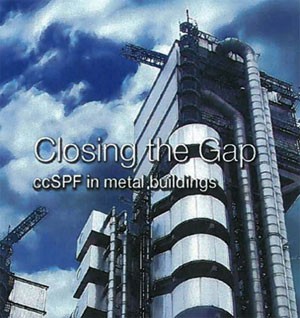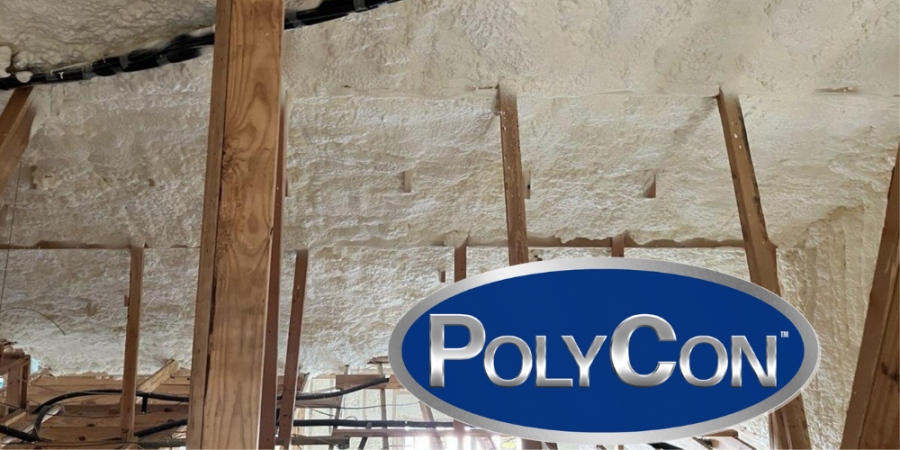Closed-Cell Spray Foam to Offer Significant Benefits to Metal Buildings

Metal and ccSPF share similar characteristics—for example, both are lightweight, durable, and adaptable to a range of circumstances.
The use of ccSPF can impart a number of high-performance attributes to metal roofing and cladding assemblies, from high R-value thermal insulation and good acoustical performance to wind uplift resistance and increased racking strength.
Replacing metal roofing and wall panels may cost $10 to $13 per square foot. In contrast, a ccSPF application can range from $3 to $5 per square foot—less than half the cost—and provide extra insulation and waterproofing, in addition to other benefits.
When properly designed, constructed, and maintained, a metal building or roof assembly should last 15 to 30 years before requiring serious maintenance. Nevertheless, thousands of metal building and roofing assemblies need retrofit or replacement long before the end of their expected lifespan.
Factors critical for energy efficiency and durability must be addressed in new and retrofit construction.
These include:
- Thermal shock movement;
- Moisture condensation;
- Uncontrolled air movement;
- Thermal bridging; and
- Radiant heat absorption.
Closed-cell sprayed polyurethane foam can help solve many of these concerns. The material is sprayed onto a surface as a liquid. Within seconds the foam—while still in a fluid-like state—expands 30 to 40 times its original volume to form a lightweight insulation, filling cracks, crevices, and areas difficult to reach with other products.
The material can be installed as a roofing system (or insulated exterior wall covering), or applied to the interior walls and ceiling. Both options have distinctive benefits. Various factors determine which system is appropriate for a specific metal building project.
Exterior ccSPF roofing systems
For metal roofing, a nominal 48-kg/m (3- pcf) density ccSPF is applied to a prepared substrate (e.g. metal, concrete, wood, or existing roof membrane), followed by the application of an elastromeric coating, such as acrylic, silicone, or polyurethane to provide ultraviolet (UV) protection. Some fleeced-backed, fully adhered assemblies and other single-ply systems specifically designed for sprayed polyurethane foam can also be installed over ccSPF insulation. The foam is self-flashing around most penetrations and parapet walls, and is flexible enough to withstand some structural building movement (generally deflections of less than 13 mm [0.5 in.]).
Movement due to thermal shock
Metal expands and contracts with varying ambient temperatures, causing fasteners to wear and pull out, flashing to delaminate and separate, metal panels to separate, and welds to break loose—all of which can result in roofs leaking. The consequence of such leakage can be serious water damage and loss of structural integrity.
Installed in a retrofit roofing system, ccSPF eliminates thermal shock movement by providing a continuous layer of highly effective insulation above the roof deck. Metal is an effective heat conductor. Lawrence Berkeley National Laboratories (LBNL) has measured dark-colored roof substrates up to 88 C (190 F) on a 35-C (95-F) day, and up to 70 C (160 F) on a dark, gray-colored surface (the color of most metal roofs). Continuous insulation stop the metal roof deck and framing members reduces the temperature differential between the roof deck and interior temperatures. This reduction essentially puts the roof to ‘sleep,’ minimizing thermal expansion and contraction caused by varying temperature levels.
Condensations
As a good conductor, metal promotes condensation if the exterior and interior building climates collide on its surface, creating dewpoint conditions. The selective use of vapor retarders, continuous insulation, and air barriers helps prevent condensation. However, the many angles, tight corners, irregular surfaces, cracks, and crevices on a typical roof and walls make it difficult to properly install sheet, membrane, board stock, and self-adhering peel-and-stick products such as vapor barrier systems.
Poorly insulated and sealed metal buildings experience significant sweating, especially if they are climate-controlled using HVAC systems. The moisture condensation can cause water damage to the building interior and premature metal corrosion. Corrosion to a metal roof decking system can be a major safety hazard for anyone with roof access for service or repairs.
Condensation can easily form inside a poorly insulated metal building with interior humidity as low as 20 percent. With ccSPF sprayed to the existing roof deck, a continuous layer covers fasteners, metal panels, and roof penetrations (e.g. pipes and supports), and completely separate metal beams, joists, purlins, and the metal roof deck panels from contact with the outside temperature and humidity. This thermal break eliminates the potential for condensation.
Air Movement
Metal buildings are difficult to make airtight. Metal panels do not have good air seals along intersections of walls, roofs, and floors. Consequently, large amounts of air can travel into and out of these structures unless an effective air barrier system is installed. It can be challenging to apply peel-and-stick membranes in metal buildings—the tight, irregular-shaped edges, corners, and junctions complicate the effective installation of the membranes as an air seal.
However, when ccSPF is sprayed onto the roof surface as a liquid, its ability to expand significantly and fill cracks, crevices, and voids offers a complete air seal around and through roof protrusions such as vents, pipes, stacks, structural supports, parapet walls, and drains. The National Institute of standards and Technology (NIST) estimates effective air barrier systems could prevent up to 83 percent of air leakage in non-residential buildings, which would save more than 40 percent on gas bills and over 25 percent on electricity consumption.1
Thermal Bridging
Thousands of fasteners and welds intersecting with hundreds of metal beams and panels conduct heat into and out of metal buildings, diminishing the effectiveness of insulation. According to American Society of Heating, Refrigerating, and Air-conditioning Engineers (ASHRAE) and Oak Ridge National Laboratory (ORNL), fasteners alone can reduce the effective insulation value by up to 31.5 percent, depending on the number and type used.
Closed-cell sprayed polyurethane foam eliminates thermal bridging by providing a continuous, fully adhered layer of insulation over existing thermal bridges in the roof deck and/or assembly.
Solar absorptivity
The typical gray-colored metal roof can get quite hot from the sun’s rays, reaching up to 65 to 75 C (150 to 170 F) on a 32 C (90 F) day. The resulting heat transmitted into the building makes the HVAC equipment work harder to cool the building. Dark-colored roofs, parking lots, and roads collectively contribute to a temperature increase in an urban area, causing the urban heat island (UHI) effect.
Commercial ccSPF roofing systems can cover dark colored roof substrates with continuous insulation that is then typically covered with a high-reflective and low-emissivity (low-e0 cool roof coating. Radiant energy-refracting insulation combined with a refracting insulation combined with a reflective coating significantly reduces rooftop temperatures.
Figure 1 (Below) demonstrates how ccSPF roofing systems prevent thermal bridging and radiative heat absorption.
 Leaks and seals
Leaks and seals
With metal roofs and buildings, it can be challenging and costly to identify and locate water leaks due to irregular surfaces and angular corners/junctions. Flashings tend to move, increasing potential for water leaks that may be hard to detect and stop.
Closed-cell sprayed polyurethane foam conforms to these irregular surfaces, corners, and junctions forming a fully adhered, seamless waterproofing membrane that helps eliminate leaks.
Figure 2 (below) shows how closed-cell foam inhibits water from penetrating the foam and traveling laterally, even if the surface is damaged. Repairs are easily done with sealant or foam packs.
 Energy efficiency
Energy efficiency
There is a higher risk for poor energy efficiency in metal buildings if factors such as air infiltration, radiation, and thermal bridging are inadequately addressed. Traditional insulation techniques (e.g. installing fiberglass, cellulose, or board stock) poorly control these factors—consequently, the forces of convection, conduction, and radiation heat transfer frequently rob many metal buildings of their energy efficiency.
Employing ccSPF roofing assemblies can increase energy efficiency in metal buildings in four ways. Closed-cell sprayed polyurethane foam roofing:
- Is applied above the roof deck, completely separating exterior and interior temperatures;
- Is typically surfaced with light-colored and reflective materials;
- Eliminates thermal bridging by providing a continuous layer of insulation over existing thermal bridges in the roof deck and or/ assembly; and
- Possesses a very high aged R-value of 6 to 7 per inch, depending on manufacturer and the particular formulation specified.
Research compiled by Mark Bomberg, PhD, PE—a scientist at the National Research Council of Canada (NRC) who studied ccSPF performance in buildings and authored Spray Polyurethane Foam in External Envelopes of Buildings—confirms they can dramatically increase the energy efficiency of metal buildings and metal roof assemblies.2
Severe weather resistance
Sever weather is the toughest test for any building system or component. High winds, airborne projectiles, wind-driven water, flooding, hail, and snow are among the hazards that threaten buildings and their occupants. Wind damage claims alone tally hundreds of millions of dollars (Figure 3).
 Metal roofs may appear highly resistant to sever weather. However, high winds can find weak spots in any roof assembly. In metal roofs, the weak spot could be a poor weld, rusted panel, or fastener that has started to back out. Once the weak spot gives, the wind peels back the rest of the metal panel, exposing the interior. Wind-driven debris and hail do not typically cause leaks to metal roofs, but can eave unsightly dents difficult to remedy.
Metal roofs may appear highly resistant to sever weather. However, high winds can find weak spots in any roof assembly. In metal roofs, the weak spot could be a poor weld, rusted panel, or fastener that has started to back out. Once the weak spot gives, the wind peels back the rest of the metal panel, exposing the interior. Wind-driven debris and hail do not typically cause leaks to metal roofs, but can eave unsightly dents difficult to remedy.
Hurricane investigations conducted by NIST, National Roofing Contractors Association (NRCA), Roofing Industries Committee on Weather Issues (RICOWI), and other groups show closed-cell sprayed polyurethane foam assemblies have a remarkable performance track record on buildings in sever weather situations. Many manufacturers of ccSPF systems also offer an unlimited wind warranty, providing assurance these roofing membranes will not blow off regardless of wind speed.
In natural disasters, especially hurricanes, ccSPF roof systems have shown remarkable resistance to high wind uplift and blow-off. This characteristic results from its spray-applied application, strong adhesion, lack of need for fasteners, and absence of joints or edges for the wind to grab onto.
RICOWI’s Hurricane Katrina Investigation (Team 1) documented more than 185,800 m2 (2 million sf) of ccSPF installed to metal roof decks and buildings that survived the 2005 storm with minimal damage, when other buildings next to them were seriously damaged from pressurization and high winds.4
According to roofing industry experts, ccSPF is a very good energy impact-absorbing material. Hail and wind-driven missile damage rarely causes leaks in a ccSPF roof.
Interior ccSPF insulation systems
Typical ccSPF interior wall or ceiling insulation systems entail application of spray foam at a nominal density of 32 kg/m3 (2 pcf) onto a properly prepared surface—clean, dr, and free of contaminants—in multiple lifts averaging approximately 25 to 50 mm (1 to 2 inc.) in thickness per lift. The foam sets up in minutes and is then covered with an application of a thermal barrier (in interior spaces) or an ignition barrier (in walls, attics, or crawlspaces). The foam is self-flashing around most penetrations. The materials is also flexible enough to withstand some structural building movement—typically less than 13 mm (0.5 in.).
As with roofing assemblies, ccSPF in interior insulation applications can significantly benefit conditions in metal buildings. It can also enhance the durability of metal buildings, providing structural enhancements as evidenced by research conducted after Hurricanes Katrina and Dolly.5
Movement and Stuctural Integrity
As with the roofs, metal buildings tend to move due to thermal shock. In some cases, this movement causes fasteners to back out and welds to loosen. These dynamic effects may result in water leaks, corrosion, and premature failure of metal panels. In severe weather, high winds can peel the fatigued metal panels from their structural supports and framing.
Application of ccSPF can increase both the racking and structural strength of existing metal buildings. The degree of structural hardening depends primarily on the strength of the building. For example, a post-frame constructed building with 29-gage corrugated metal panels will benefit from an interior application of ccSPF considerably more than a I-beam modular constructed building with a 22-gage metal panel.
Once installed, ccSPF ‘glues’ the metal assembly together, reducing potential for movement by adding a tensile strength average of 103 to 172 kPa (15 to 25 psi). The sprayed foam also creates a secondary barrier against moisture intrusion, diminishing the possibility of corrosion caused by water leaks into the building.
Energy, air movement, and moisture
Designers face severe challenges when trying to provide energy efficiency and control air movement and moisture in metal buildings. In Spray Polyurethane Foam in External Envelopes of Buildings, Bomberg discusses the importance of “controlling interactions of heat, air, and moisture control when installed to building interior.
Research conducted at Architectural Testing Inc. (ATI) and ORNL demonstrated ccSPF in walls and attics performs 20 to 50 percent more efficiently than conventionally insulated assemblies such as those using fiberglass.
As discussed with roof assemblies, the numerous fasteners and welds intersecting with metal beams and panels conduct heat into and out of buildings, lowering insulation’s effectiveness. Studies by ASHRAE show thermal bridging in metal buildings can rob up to 40 percent of the insulation’s energy efficiency. As ccSPF can be spray-applied to provide continuous insulation extending beyond the metal panels to include beams, girts, purlins, fasteners, and other metal connections and junctions on the building interior, the potential for thermal bridging is greatly reduced.7
Air Leakage
Air-sealing metal buildings can be a significant challenge. The unusual configurations of the metal panels, beams, and girts often leave large gaps at ceiling-wall joints and wall-floor junctions. Those voids and cracks allow moisture-driven air in and out of the building making it extremely difficult to control interior temperature, humidity, and indoor air quality.
Blower door tests and other whole building analyses consistently show ccSPF significantly improves a metal building’s air-sealing properties, saving up to 40 percent in energy costs.8
Indoor Air Quality
Uncontrolled transfer of heat, air, or moisture within buildings can lead to condensation—and consequently, poor indoor air quality. By air-sealing the building, providing effective insulation, and reducing potential for condensation, ccSPF lowers the likelihood of mold growth. As an inorganic material, closed-cell spray polyurethane foam does not provide a food source for mold. The air tightness performance capabilities of ccSPF allow the HVAC equipment to function more efficiently—the ventilation system can condition air properly, promoting better IAQ and energy efficiency.
NRC studies confirm buildings air-sealed with ccSPF maintain a much better IAQ than buildings that are ineffectively air-sealed.9
Inside or outside?
Building owners and specifiers are often faced with the question of where to install the ccSPF—inside or outsie. In some situations, the answer is obvious; in others, it can be difficult to determine.
Applying ccSPF to the building interior controls structural movement better, as it emails gluing the trusses, joists, beams, and other elements directly together. The potential for poor weather conditions, such as high winds or rain, may also make interior application preferable. Conversely, installing insulation on the outside of the building provides enhanced energy efficiency, as it eliminates thermal bridging.
In cases where there is much activity inside a building—such as ongoing operations, equipment, racks, storage, furnishings, and occupied areas—the most appropriate way to use ccSPF is applying it outside the building envelope. Overspray preparation (i.e. covering or masking off areas or objects that might accidentally be oversprayed) may also affect the preferred point of application.
To determine the appropriate type of ccSPF application, basic building information is required, such as location, climate, intended use, and occupancy. Questions pertaining to major concerns or challenges should be answered. Suitable questions include:
- Are there leak, moisture, or condensation issues?
- Is energy efficiency a major concern?
- Will there be considerable work disruption from an interior application?
- Is overspray prep needed before the application?
- Is additional structural strength desired, and if so, of what type? For example, if the building is in a hurricane-prone zone and the owner would like to reinforce the whole building against wind damage, what are the options?
- What type of substrate preparation is required?
- Are there surface or assembly preparation challenges? For example, is rust treatment or replacement of fasteners or welds required?
After considering the building requirements and desired changes, the building owner should then review the characteristics and benefits for each type of ccSPF system. Regardless of whether the building owner decides to install a ccSPF system outside or inside a metal building—or use a combination of the two – research and historical evidence suggests the application provides a range of benefits.10
Click Here to read more about using spray polyurethane foam insulation in metal buildings.
Notes
1 The June 2005 National Institute of Standards and Technology (NIST) report evaluated the energy savings of an effective air barrier requirement for non-residential buildings in five American cities using the scalar ratio methodology employed by ASHRAE Standing Standard Project Committee (SSPC) 90.1, Energy Standard for Buildings Except Low-rise Residential Buildings
2 See Mark Bomberg and Joseph Lstiburek’s Spray Polyurethane Foam in External Envelopes of Buildings, CRC Press (1998), or visit www.energystorm.us/ Spray_Polyurethane_Foam_In_External_Envelopes_Of_Buildings-r17896.html.
3 Visit Insurance Services Office Inc. (ISO) at www.iso.com
4 Numbers were assigned to the various teams conducting RICOWI investigations during Hurricane Katrina. Multiple Teams were dispatched to analyze roof failure. Visit www.ricowi.com/frontEnd/content.htm?id=10.
5 See note 4.
6 See note 2.
7 For details, refer to the following studies: J. Kosny and J.E. Christian’s “Thermal Evaluation of Several Configurations of Insulation and Structural Materials for Some Metal Stud Walls,” Energy and Building (July 1995).
“Evaluation of critical factors affecting the thermal performance of metal curtain walls by simulations.” By H. Ge, MASc and P. Fazio, PhD., P.Eng., FCSCE, FASCE at eSIM 2002. Visit www.esim.ca/2002/documents/Proceedings/Sessions%203a-5.pdf
J. Kosny, A.O. Desjarlais, and J.E. Christian’s “Steel-framed Buildings: Impacts of Wall Detail Configurations on the Whole Wall Thermal Performance,” ASHRAE Transaction: Symposia 104(2): 1263-1271. Visit www.osti.gov/bridge/servlets/purl/6583150sNzV7J/webviewable/658315.pdf.
J. Kosney and J.E. Christian’s “Whole Wall Thermal Performance,” Oak Ridge National Laboratory. Visit www.ornl.gov/sci/roofs+walls/research/detailed_papers/thermal_frame/
8 According to analyses by CanAm Building Envelope Specialists Inc.
9 See M.T. Bomberg and M.K. Kumaran’s “Use of Field-applied Polyurethane Foams in Buildings” Construction Technology Update No. 32 (December 1999). Visit irc.nrc-cnrc.gc.ca/pubs/cuts/32_e.html
10 In addition to sources mentioned throughout this article, the author would like to acknowledge the following for their contributions: Arizona State University, Del E. Webb School of Construction; BASF; BaySystems North America; Metal Building Manufacturers Association (MBMA); Michelsen Technologies; National Association of Home Builders (NAHB); National Roofing Foundation; Spray Polyurethane Foam Alliance (SPFA); and TLSmith Consulting
Disqus website name not provided.










































